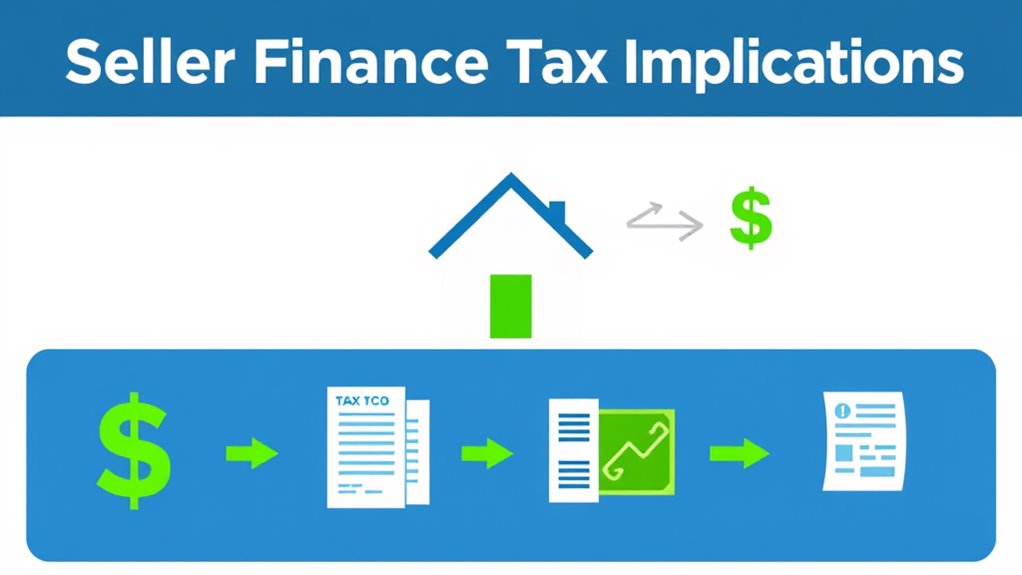Seller financing lets you buy property by obtaining credit directly from the seller, bypassing traditional banks. In this arrangement, you make payments to the seller under terms detailed in a promissory note, with the seller keeping the title until you’ve paid in full. This method offers flexibility in loan terms, making it ideal in competitive markets. However, expect higher interest rates and potentially significant down payments due to increased risk for the seller. Proper documentation and understanding legal and tax ramifications are crucial. Uncovering these nuances guarantees you’re equipped for smooth and successful property transactions ahead.
Key Takeaways
- Seller financing allows buyers to make payments directly to the seller, bypassing traditional mortgage lenders.
- The seller retains the property title until the buyer fully repays the loan.
- Loan terms like interest rates and repayment schedules are negotiable between the buyer and seller.
- A promissory note and mortgage agreement formalize the payment obligations and terms.
- Seller financing can offer faster closings and flexibility in competitive real estate markets.
What Is Seller Financing
Seller financing, often referred to as owner financing or a purchase-money mortgage, provides an alternative pathway for property transactions by allowing sellers to finance the buyer’s purchase directly. This approach bypasses traditional mortgage lenders, which can be especially advantageous for buyers facing difficulties in securing conventional loans due to poor credit or other financial constraints.
In seller financing, you, as the buyer, will make payments directly to the seller rather than through a bank or financial institution. The transaction is typically formalized with a promissory note. This vital document outlines the terms of the agreement, including the interest rate, repayment schedule, and any other specific conditions agreed upon. Unlike the rigorous qualification process required for a traditional mortgage, seller financing often involves less stringent criteria, which might ease your path to homeownership.
One key aspect of seller financing is that the seller retains the title to the property until the loan is completely paid off. This arrangement not only secures the seller’s interest in the property but also incentivizes you to adhere to the agreed payment terms. Compared to the lengthy and often complex procedures associated with traditional mortgages, seller financing can lead to a faster closing process, enabling you to move into your new home more quickly.
Seller as the Lender
As the seller acting as the lender, you’re in a position to negotiate loan terms that best suit your financial goals and the buyer’s needs. You’ll want to carefully outline repayment plans and interest rates, ensuring they’re competitive yet profitable. Additionally, managing default risks becomes essential, requiring you to establish clear consequences and safeguards in the event the buyer fails to meet their obligations.
Negotiating Loan Terms
When entering into a seller financing arrangement, understanding how to effectively negotiate loan terms is fundamental for both parties involved. You’ll want to focus on key elements like interest rates, repayment schedules, and down payment amounts. Interest rates in these deals are often higher than conventional loans, reflecting the increased risk the seller takes on. As a buyer, you might negotiate for a rate that’s competitive yet fair, balancing the seller’s risk with your financial capacity.
Repayment schedules can be tailored to suit both parties, often ranging from 5 to 30 years. Some agreements may include balloon payments, where you’ll need to pay off the remaining balance in a lump sum at the end of the term. It’s critical to evaluate how this aligns with your long-term financial plans.
The importance of a down payment can’t be overstated—typically around 10% of the purchase price—to safeguard the seller and demonstrate your commitment. Finally, documenting these negotiated terms clearly through a promissory note and mortgage agreement is significant. This guarantees both parties are fully aware of their rights and obligations, reducing potential disputes down the line.
Managing Default Risks
Although seller financing can offer significant flexibility and benefits, it’s vital to manage default risks effectively to protect your investment. As a seller acting as the lender, implementing specific strategies can mitigate potential issues. Here’s how you can safeguard your financial interests:
- Require a Substantial Down Payment: By insisting on at least a 10% down payment, you reduce the risk of default. This guarantees the buyer has a vested interest in the property, aligning their commitment with yours.
- Conduct Thorough Credit and Background Checks: Evaluating the buyer’s financial stability and repayment capability with detailed credit checks helps assess the likelihood of default. This proactive step can prevent future complications.
- Include a Well-Defined Default Clause: Clearly outline your rights and recourse procedures in the promissory note. This clause should specify actions in case of missed payments, providing a legal framework to address defaults.
- Secure the Loan with a Mortgage or Deed of Trust: Recording this with the local authority grants you the legal right to foreclose if defaults occur. This legal backing is fundamental for protecting your financial interests.
Regularly monitoring payments and maintaining open communication further minimizes default risks, guaranteeing a smoother seller financing experience.
Key Benefits for Buyers
 Seller financing offers a unique opportunity for buyers, particularly those who face challenges securing traditional mortgages due to poor credit or limited access. By circumventing conventional financing hurdles, you can work directly with sellers to negotiate terms such as interest rates, down payments, and repayment schedules. This flexibility often results in conditions more favorable than those provided by banks. Without the need for extensive credit checks, the approval process is not only quicker but also facilitates faster closings compared to traditional financing.
Seller financing offers a unique opportunity for buyers, particularly those who face challenges securing traditional mortgages due to poor credit or limited access. By circumventing conventional financing hurdles, you can work directly with sellers to negotiate terms such as interest rates, down payments, and repayment schedules. This flexibility often results in conditions more favorable than those provided by banks. Without the need for extensive credit checks, the approval process is not only quicker but also facilitates faster closings compared to traditional financing.
One of the considerable benefits of seller financing is the reduction in closing costs. Traditional loans often require appraisals, inspections, and various fees, which can considerably increase the overall expense of purchasing a property. Seller financing typically bypasses many of these costs, making it a cost-effective choice. Additionally, in competitive real estate markets, this approach allows you to secure properties that might otherwise be out of reach due to stringent lending standards.
Here’s a breakdown of the key benefits you might enjoy:
| Key Benefits | Description |
|---|---|
| Flexible Terms | Negotiate interest rates, down payments, and schedules |
| Easier Approval | Less stringent credit requirements, faster processing |
| Lower Closing Costs | Reduced need for appraisals and inspections |
| Competitive Edge | Access properties in highly competitive markets |
| Direct Negotiation | Personalize terms directly with the seller |
Given these advantages, seller financing can be a strategic pathway for you to own a home, especially when traditional financing proves challenging. It empowers you to navigate the property market with greater agility and efficiency.
Advantages for Sellers
When you choose seller financing, you can potentially secure a higher sale price by attracting more buyers with this appealing financing alternative. Acting as the lender not only enhances negotiation opportunities but also guarantees a steady income stream through regular monthly payments, contributing to a reliable cash flow. This approach allows you to strategically align the sale with your financial goals while maintaining control over the sale terms.
Higher Sale Prices
In the domain of property transactions, leveraging seller financing can considerably boost sale prices due to its appeal to a broader range of buyers, especially those who might struggle to secure traditional loans. By offering flexible financing options, you can attract more potential purchasers, hence increasing competition and allowing you to command higher sale prices. Here’s how seller financing benefits the seller:
- Expanded Buyer Pool: Some buyers can’t qualify for traditional loans, but seller financing opens doors, increasing demand and raising sale prices.
- Negotiable Terms: You have the power to set favorable terms, such as interest rates and repayment schedules, which reflect in a higher sale price. The flexibility of these terms can make the property more attractive to buyers.
- Faster Closures: Properties sold with seller financing often close faster, reducing market time and taking advantage of favorable conditions, which can justify a higher asking price.
- Appraisal Freedom: By bypassing traditional appraisal requirements, which sometimes limit sale prices, you can set a more competitive price.
Steady Income Stream
 While traditional property sales might provide an immediate influx of cash, seller financing offers the unique advantage of generating a steady income stream. By structuring the sale as seller financing, you receive monthly payments from the buyer, ensuring consistent cash flow. This arrangement can be particularly beneficial if you’re seeking financial stability, such as during retirement or if you desire a passive income source. Unlike a one-time payment, the monthly payments from seller financing can provide a reliable long-term income.
While traditional property sales might provide an immediate influx of cash, seller financing offers the unique advantage of generating a steady income stream. By structuring the sale as seller financing, you receive monthly payments from the buyer, ensuring consistent cash flow. This arrangement can be particularly beneficial if you’re seeking financial stability, such as during retirement or if you desire a passive income source. Unlike a one-time payment, the monthly payments from seller financing can provide a reliable long-term income.
In addition, seller financing allows you to potentially negotiate a higher sale price. Buyers often value the convenience and accessibility of this financing option and may be willing to pay a premium. This means your monthly payments could be more substantial than they would be in a conventional sale. Furthermore, spreading out the payments over time might offer tax benefits, like capital gains deferral, which can further enhance your financial situation.
Another advantage is avoiding immediate expenses related to repairs or renovations. Traditional sales often require properties to meet strict lender standards. With seller financing, you can bypass these costly updates, thereby reducing your financial burden and enhancing the overall profitability of the sale.
Potential Risks Involved
Maneuvering seller financing in property deals requires careful reflection of potential risks that could jeopardize both parties’ interests. As a seller, you face the risk of buyer default, which can lead to lengthy and costly foreclosure processes if the buyer fails to make payments. It’s vital to assess the buyer’s financial stability to mitigate this risk. On the other hand, buyers might encounter higher interest rates compared to traditional mortgages, increasing overall costs over the loan’s duration. This can make the financing option less attractive if the rates markedly impact affordability.
Legal complexities are another aspect to take into account. Poorly documented agreements can result in disputes over the terms and conditions, which can be costly and time-consuming to resolve. Both parties must ascertain that all legal documentation is thorough and clear to avoid misunderstandings.
Here’s a breakdown of potential risks:
- Buyer Default: Sellers may endure financial strain due to prolonged foreclosure processes.
- Interest Rates: Buyers face heightened costs due to potentially higher interest rates than conventional options.
- Legal Complexities: Poorly documented agreements can lead to disputes and complicated resolutions.
- Cash Flow Issues: Sellers might struggle financially if buyers make lower-than-expected payments or default.
Additionally, if the seller has outstanding encumbrances on the property, buyers could face unclear title issues, affecting ownership rights. To safeguard against these risks, both parties should engage in thorough due diligence, consult legal experts, and ascertain all documentation is precise and detailed. By doing so, you can navigate the complexities of seller financing with greater confidence and security.
Types of Financing Arrangements
Understanding the potential risks in seller financing is just the beginning of your journey into this alternative property transaction method. Exploring various types of financing arrangements can help you tailor a deal that best fits your needs. One common arrangement is the all-inclusive mortgage. Here, the seller carries the entire balance of the mortgage, minus the down payment, allowing you to make a single monthly payment that combines the original mortgage and the seller’s financing portion. This can simplify the payment process and provide a streamlined financial obligation.
Another option is the junior mortgage, where the seller finances the gap if traditional lenders cover less than 80% of the property’s value. This arrangement allows you to secure additional funds directly from the seller, bridging the financial shortfall that might otherwise hinder your purchase.
The land contract method involves making payments to the seller until the total purchase price is met. Under this arrangement, the seller retains the legal title until you fulfill the contract terms, offering a unique blend of flexibility and security for both parties. Similarly, a lease option lets you lease the property with the choice to purchase later. Often, rental payments can include credits toward the purchase price, providing flexibility and potential savings.
Lastly, with an assumable mortgage, you can take over the seller’s existing mortgage, subject to lender approval. This can be advantageous if the original terms are more favorable than current market rates. Each of these seller financing methods offers distinct benefits and challenges, enabling you to choose the path that aligns with your financial strategy and long-term goals.
Structuring the Deal
 When structuring a seller financing deal, it is crucial to negotiate the key terms that will govern the transaction, such as the interest rate, repayment schedule, and down payment amount. These elements can vary widely, depending on what both parties agree upon. At the heart of seller financing is the promissory note, which formalizes the terms of the deal. This document guarantees that both you and the seller are on the same page regarding obligations and rights throughout the repayment period.
When structuring a seller financing deal, it is crucial to negotiate the key terms that will govern the transaction, such as the interest rate, repayment schedule, and down payment amount. These elements can vary widely, depending on what both parties agree upon. At the heart of seller financing is the promissory note, which formalizes the terms of the deal. This document guarantees that both you and the seller are on the same page regarding obligations and rights throughout the repayment period.
To effectively structure the deal, consider the following elements:
- Interest Rate: Determine a rate that reflects current market conditions and the risk involved. This rate can be a fixed or variable percentage, impacting the overall cost of the loan.
- Repayment Schedule: Tailor a payment plan that suits your financial situation. You might opt for lower initial payments that gradually increase or choose a balloon payment at the loan’s end.
- Down Payment: Decide on an upfront amount that shows commitment while providing the seller with immediate funds. A larger down payment could result in more favorable terms.
- Security: Secure the loan with a mortgage or deed of trust, creating a lien on the property. This allows the seller to reclaim the property through foreclosure if you default on payments.
Legal Considerations
Steering through the legal landscape of seller financing requires a thorough understanding of both state and local regulations to guarantee a smooth transaction. In Texas, for instance, the SAFE Act mandates that sellers offering financing must be licensed, with exceptions for transactions involving a seller’s homestead or family members. Knowing these nuances helps you navigate the legal requirements effectively.
Proper documentation is essential in seller financing. A promissory note and a deed of trust are necessary to clearly outline the terms of the agreement. These documents protect both parties by specifying payment schedules, interest rates, and default conditions. Inadequate documentation or ambiguous terms can lead to legal disputes, so it’s important to involve real estate attorneys who can draft and review these agreements meticulously.
You should also remain vigilant about potential title complications. If the seller has existing liens or encumbrances on the property, it could affect your ownership rights. Securing a clear title is part of the due diligence process, and professional legal advice can help identify and resolve these issues before they become significant problems.
Additionally, local real estate laws may impose further requirements or restrictions on seller financing arrangements. It’s important to conduct thorough research and verify compliance with these laws to avoid future legal challenges. Real estate attorneys experienced in local regulations can provide valuable guidance, confirming that all aspects of the transaction adhere to legal standards. By taking these precautions, you can safeguard your investment and secure a successful property deal.
Tax Implications

While steering through the legal intricacies of seller financing is important, understanding the tax implications can be just as vital for both buyers and sellers. When engaging in seller financing, both parties must be aware of how these transactions can affect their tax obligations. Here’s a breakdown to guide you through:
- Deferring Capital Gains Tax: Sellers can benefit from deferring capital gains tax through installment sales. Instead of paying a lump sum, you spread the tax liability over several years as you receive payments, potentially easing your annual tax burden.
- Ordinary Income: Monthly payments you receive might be considered ordinary income. Depending on your overall tax situation and the financing agreement terms, these payments are subject to income tax. Make sure to evaluate how this fits into your annual income tax plan.
- Interest Deduction for Buyers: As a buyer, if you meet IRS requirements, you might be able to deduct the interest paid on seller financing just like traditional mortgage interest. This can greatly reduce your taxable income, offering a welcome financial reprieve.
- Consulting a Tax Professional: Tax implications can vary widely based on local laws and individual circumstances. It’s essential to consult with a tax professional to understand your specific obligations and benefits. They can offer tailored advice, ensuring you comply with tax laws while maximizing your financial position.
Additionally, sellers should meticulously record payments and related expenses for accurate tax reporting. By staying informed and proactive, you can navigate the complexities of seller financing taxation effectively.
Risk Mitigation Strategies
To mitigate risks in seller financing, you should start by thoroughly evaluating the buyer’s financial health through detailed loan applications and verification of their financial information. This step guarantees you can assess their capability to meet payment obligations, thereby reducing the likelihood of default. Additionally, securing the loan with the property enables you to initiate foreclosure if necessary, protecting your investment and financial interests.
Buyer Financial Assessment
Before entering a seller financing agreement, it’s crucial to conduct a thorough buyer financial assessment to mitigate potential risks. This assessment guarantees the buyer’s repayment capability and helps protect your interests. A detailed evaluation involves several key steps:
- Loan Application: Require the buyer to complete a detailed loan application. This should include financial statements, credit history, and proof of income. These documents provide insight into their financial stability and ability to meet payment obligations.
- Verification: Verify the buyer’s financial information. Assess employment stability and existing debts to gauge the risk of default. This due diligence helps confirm the buyer can make consistent payments.
- Contract Contingency: Implement a sales contract contingency. This allows you to back out if the buyer’s financial status isn’t satisfactory, offering an additional layer of protection against potential financial pitfalls.
- Down Payment: Insist on a minimum down payment of at least 10% of the purchase price. This reflects the buyer’s commitment and lessens the risk to you in case of default.
Securing Loan With Property
Even though seller financing can be advantageous, securing the loan with the property itself is a significant risk mitigation strategy. Recording a mortgage or deed of trust is imperative, as it legally binds the property to the loan. This enables you, the seller, to foreclose if the buyer defaults, safeguarding your financial interests. It’s important to require a down payment of at least 10%, guaranteeing that the buyer has a significant investment in the property. This vested interest reduces the likelihood of default, as the buyer risks losing their initial investment.
Conducting a thorough appraisal of the property is another protective measure. By establishing its value, you guarantee the loan amount doesn’t exceed the property’s worth, providing a financial safety net. Before finalizing any agreements, request a detailed loan application from the buyer to verify their financial stability and repayment capability. This due diligence on the buyer’s finances helps you assess the risk level accurately. Additionally, including contingencies in the sales contract that require your approval of the buyer’s financial situation is prudent. This guarantees the buyer meets specific financial criteria before the transaction proceeds, further reducing risk.
Importance of Documentation
 Documentation serves as the backbone of seller financing agreements, guaranteeing all parties are clear on the terms and conditions of the loan. This clarity is essential in minimizing disputes and safeguarding interests. Here’s why documentation is indispensable in such deals:
Documentation serves as the backbone of seller financing agreements, guaranteeing all parties are clear on the terms and conditions of the loan. This clarity is essential in minimizing disputes and safeguarding interests. Here’s why documentation is indispensable in such deals:
- Promissory Note: This key document outlines the loan’s specifics, including interest rates, repayment schedules, and default consequences. Both parties must sign it to formalize their understanding and commitment.
- Legal Lien: Recording a mortgage or deed of trust with local authorities establishes a legal lien on the property. This step is necessary for creating a binding agreement that both parties can rely on, protecting the seller if the buyer defaults.
- Title Insurance: Securing title insurance is a wise move to shield against claims on the property. It verifies that the seller’s title is clear, guaranteeing no hidden encumbrances could derail the sale.
- Compliance with Real Estate Laws: Written agreements must adhere to local real estate laws and regulations. Proper disclosures are necessary to protect both buyer and seller, guaranteeing the contract is enforceable under the law.
Each of these elements plays a significant role in the documentation process. They collectively guarantee the transaction is legally sound and mutually beneficial. By following these steps, you can help prevent misunderstandings and guarantee a smooth transaction. It’s essential to engage with these processes diligently, as they form the legal foundation upon which your seller financing agreement stands. Understanding the importance of each document and its role can protect your interests and facilitate a successful property deal.
Professional Assistance Needed
While maneuvering through the complexities of seller financing, enlisting professional assistance is vital to secure a seamless and legally compliant process. Engaging a real estate attorney is significant. They ascertain your seller financing agreements align with local laws and regulations, preventing costly legal missteps. Their expertise in drafting and reviewing contracts is invaluable for safeguarding your interests.
A real estate agent experienced in seller financing can provide you with valuable insights into current market conditions. They assist in negotiating favorable terms, benefiting both buyers and sellers. With their extensive knowledge, they help you understand the intricacies of seller financing, guaranteeing you make informed decisions.
Consulting a financial advisor is another important step. They help you navigate potential tax implications, especially around capital gains taxes. For sellers, structuring the financing to maximize financial benefits requires in-depth financial analysis, which only a skilled advisor can provide. Their guidance guarantees you capitalize on the transaction without unforeseen tax burdens.
Additionally, loan servicing companies can handle the administrative aspects of seller financing, such as payment tracking and issuing regular statements to buyers. This professional help relieves you from the burden of managing these tasks, allowing you to focus on other aspects of the property deal.
Conclusion
Steering seller financing requires you to balance opportunity and caution. On one hand, it offers flexible terms and quicker deals; on the other, it presents potential risks and tax implications. This dual nature demands thorough documentation and professional guidance. By understanding both the benefits and the pitfalls, you can make informed decisions, turning complexities into advantages. Your path in property deals becomes not just a transaction, but a strategic journey toward financial growth.




